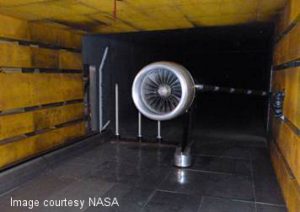ATA Engineering issued patent for high-resolution acoustic holography advancement.
SAN DIEGO, Calif., October 16, 2014 – ATA Engineering has been issued a patent for “Methods and Apparatus for High Resolution Continuous Scan Imaging,” an invention that represents a notable advancement in acoustic measurement and signal processing methods.
ATA’s patented technology was inspired by the need to accurately characterize the near- and far-field sound field produced by high-performance jet aircraft. The noise from these aircraft is a significant concern for communities near airfields and for personnel who work near these aircraft. However, reducing this noise has long presented significant technical challenges, largely due to the difficulty of completely defining the characteristics of time-varying distributed acoustic sources that can be more than twenty fully expanded jet diameters in length. And until now, acoustic holography systems able to provide an understanding of these noise sources have tended to be expensive and inefficient, demanding high sensor counts, long engine run times, and high hardware costs.
ATA’s novel continuous scan measurement technology both alleviates these drawbacks and provides improved results with near-infinite spatial resolution and reduced spatial aliasing error. The use of continuously moving microphone sensors, as opposed to traditional fixed-array methods, can reduce overall testing time by half while using a far smaller number of sensors (fewer than 150). Moreover, it allows the sound field to be broken down into its principal components for greater insight. The technique also involves an optimal method for calculating transfer functions between the roving microphones and a set of fixed reference sensors, retaining more information, particularly at higher frequencies where conventional techniques fail.
With the improved understanding of noise sources and noise propagation enabled by this advancement, aircraft designers will be able to develop improved noise mitigation technologies for present and future aircraft and aircraft engines. The techniques will be beneficial to the development of low-bypass-ratio, jet-noise-dominated aircraft engines as well as high-bypass-ratio, fan-noise-dominated aircraft engines. The technology may also enable design modifications in rocket engines, reducing excitation levels during liftoff and increasing reliability.
In the invention of High Resolution Continuous Scan Imaging, ATA drew upon 30 years of experience performing high-channel-count, high-resolution dynamic testing and analysis across a wide variety of industries. The Air Force Research Laboratory (AFRL) also provided support for the experimental and modeling portion of the work leading to this invention under Phase II SBIR Contract No FA8650-07-M-6784, with Mr. Richard McKinley as technical monitor. ATA’s history of innovation includes development of the Alias-Free Polyreference curve-fitting technique and the Multi-Sine vibration testing method. Additionally, ATA holds two patents in aerospace and launch vehicle design.
High-Resolution Continuous Scan Imaging is protected under US patent number 8,843,342.
For more information, please contact ATA Engineering at 858.480.2000.


